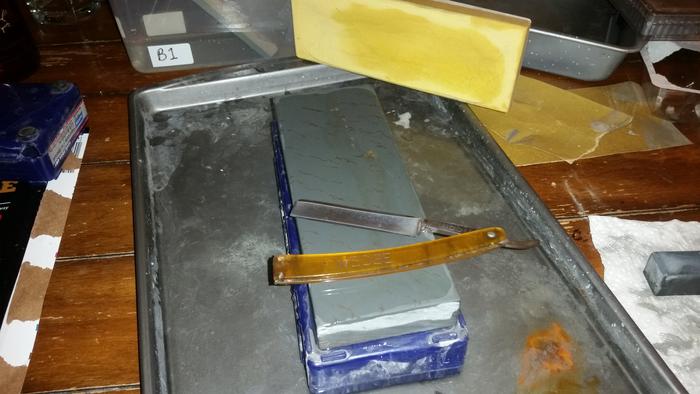Results 11 to 20 of 29
Thread: Poor boy's stones
-
02-14-2016, 06:09 PM #11illegitimum non carborundum



- Join Date
- Jan 2008
- Location
- Rochester, MN
- Posts
- 11,552
- Blog Entries
- 1
Thanked: 3795
I am a little surprised at your perception that your Chinese hone is soft. I have handled at least a dozen if them and never have encountered one I would call soft.
I'm not disagreeing with your assessment, I just find it to be unusual.
-
02-14-2016, 07:01 PM #12
-
02-14-2016, 10:20 PM #13Senior Member

- Join Date
- Sep 2015
- Posts
- 695
Thanked: 77
Hit up your local flea markets often it's rare that I picked up things such as Escher stones for as little as $10
-
02-14-2016, 10:48 PM #14Senior Member

- Join Date
- Sep 2013
- Location
- NW Indiana
- Posts
- 1,060
Thanked: 246
The Norton lapping stone isn't too soft to lap pretty much any natural stone - it's Silicon Carbide - far harder than any natural abrasive except diamond. However, it will go out of flat fairly rapidly, so isn't real useful for lapping harder stones if you don't have a method to keep it reliably flat during the process. If having trouble lapping a hard stone with one, start a little slurry on the Norton lapping stone first - it will tear right through anything just like loose grit SiC. Personally I would far rather use a diamond plate (most useful on slightly softer stones IMO) or loose grit SiC though.
-
02-15-2016, 12:22 PM #15Junior Member

- Join Date
- May 2007
- Posts
- 19
Thanked: 0
I am new at polishing to this level so maybe I am just wrong. I based my assessment on two things... 1. When using my Norton flattening stone the material on the waterstone came off quickly and in large amounts. 2. After honing with any given stone I use a jeweler's loop and a bright light to assess the edge. My 6000 king leaves the edge with almost no discernible marks, then I moved to the waterstone and it left striated marks on the mirrored surface. I had to go back to the 6000 to take them out.
This leaves me with two thoughts: 1. The natural waterstone seems courser than 6000 grit AND 2. Since my 6k King will impart a mirror finish it seems finer than 6k.
-
02-15-2016, 12:33 PM #16Senior Member

- Join Date
- Sep 2013
- Location
- NW Indiana
- Posts
- 1,060
Thanked: 246
Well, forgot to mention this earlier, but natural stones of the harder variety need to be smoothed out to a certain threshold to give the best edges. If you tried to hone a razor on the C12k immediately after lapping it with the Norton SiC lapping stone, you weren't giving the stone a fair shake. You'll want to either try polishing it up with another stone or possibly some wet/dry up to a finer grit.
-
02-15-2016, 01:40 PM #17Junior Member

- Join Date
- May 2007
- Posts
- 19
Thanked: 0
-
02-15-2016, 03:49 PM #18

I would at least go up to 1000, and always use water!
"Every normal man must be tempted at times to spit on his hands, hoist the black flag, and begin to slit throats." -H. L. Mencken
-
02-15-2016, 05:49 PM #19Senior Member



- Join Date
- Dec 2014
- Location
- Virginia, USA
- Posts
- 2,224
Thanked: 481
This is a photo of my PHIG. Notice the mirror like surface:

Mine was hard as all unholy h*** and took several hours to lap flat. Then it took a lot of trial and error figuring out how to prep the surface. I finally got tired of fighting it, ran it through wet/dry up to 2000 grit, and ran my Norton 4k and 8k over it several hundred laps each. I'll go ahead and say it, this is probably overkill - you can probably stop at 1k or 2k sand paper. But the results can't be argued, it does work.
The Norton lapping stone is rough. It will leave scratches in just about anything you lap. In my opinion, this will need to be addressed before the hone is used - especially a finishing stone. I've found my 1k is more firgiving, the lapping stone is all it needs. The 4k needs paper to 600 or 1000. It goes without saying I used 320 and 600 on my 1k, and 320, 600, 1k and 2k on my 4k.
If you're using slurry on the PHIG it may well be dropping below your 6k 's polish. Mine does the same, with slurry it drops below 8k. By the time I finish diluting and polishing on pure water the edge is finer. Another trick you can try after using pure water, do a few laps with shave lather. Just takes patience and a lot of passes, this stone is a slow cutter.
There is a distinct possibility yours is a dud, but until you've properly prepped the surface and spent time learning how to squeeze everything out you can, I wouldn't count the stone out just yet.Last edited by Marshal; 02-15-2016 at 05:57 PM.
-
02-15-2016, 10:34 PM #20

I'm sure you've done this, but just for redundancy's sake. Round or chamfer the edges of the hone. It'll probably suck with that hone and eat paper, but it'll help frustration later


 22Likes
22Likes LinkBack URL
LinkBack URL About LinkBacks
About LinkBacks






 Reply With Quote
Reply With Quote
